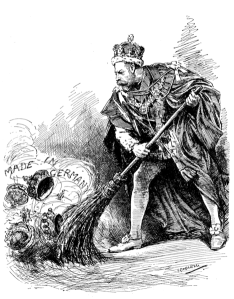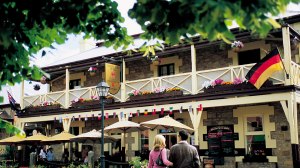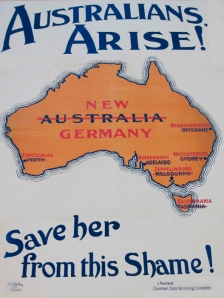The approaching centenary of The Great War or World War One seems to be focused on the ‘front line’, military figures, battlefield memorials and so on. The official designation is the Centenary of Anzac (see http://www.anzaccentenary.gov.au). It’s as though the war was fought by our innocent, fun-loving, adventurous Australian lads against blood-thirsty, incompetent, blimpish British generals. I fear wave upon wave of nationalist jingoism is about to be heaped upon us for the next four or five years.
However there are as many pasts as there are futures, and we can choose to explore different paths to the official history. Prior to the outbreak of the War there were a great many place names used in Australia that were of German origin, and reflected the patterns of settlement by German-speaking colonists. By 1914, German-born Australians formed 5% of the overseas-born population and 1% of the total population. With their locally-born descendants the community was larger than this figure suggests.
The significance of Australia’s German heritage today can be seen in the 2011 Census. People of German ancestry form 4.5% of the total population, with 83% born in Australia, 10% born in Germany and 7% elsewhere. German is the sixth-largest ancestry group, and second-largest ‘non-British’ ancestry, among Australians. German is the 8th most-spoken language in Australia. Despite this strong historical and contemporary presence, Australia’s German heritage is not well known or appreciated in the general community. This is a silent but lingering legacy of two world wars.
During the war, and especially in and after 1917, at least 96 German place names were replaced with place names that were considered more suitable or patriotic. Only about 18 of the German names were reinstated in later years.
The name changing took place in a highly charged atmosphere of anti-German feeling. People of German heritage were being excluded from jobs, business activities, land dealings and other economic and social activities, incarcerated in detention centres (called concentration camps at the time), and labeled enemy aliens.
About 73% of place name changes occurred in South Australia, but the name changing occurred in all states. The earliest was in 1915 (Bismark to Collinsvale, Tasmania) and the last in 1920 (Reinholtz’s PO to Reynold’s PO, Victoria). There may also be, at more local and personal levels, instances of the changing of German names for streets, parks, buildings and businesses, or suppressing the use of German language in schools or the press.
There was also a degree of replacing German place-names in German New Guinea after Australia occupied the German colony in 1914 (e.g. Berlinhafen to Aitape, but no change to Bismarck Sea), but it does not seem to have been as extensive as in mainland Australia.
A few instances of name changing occurred in Canada (e.g. Berlin to Kitchener, Ontario 1916), but none in New Zealand. A bill was introduced in the US Congress in 1918 to change all US towns named Berlin or Germany to Liberty or Victory, but it was never enacted. Changing German place names seems to have been predominantly an Australian phenomenon in the English-language world during the Great War.
The other major name-changing event during the war was the change of the name of the royal house from Saxe-Coburg & Gotha (or Wettin) to Windsor. By a royal proclamation of 17th July 1917, King George V changed the name of the royal house to Windsor. He also abandoned all titles held under the German Crown, stripped his German relations of their British titles and encouraged the anglicisation of all German sounding family names (e.g. Battenberg to Mountbatten). The same happened in Belgium where the royal house name was changed in 1917 from Saxe-Coburg & Gotha to van België (Dutch)/de Belgique (French). The royal house names, whether in their German form or as Windsor or van België/de Belgique, were also place names. The change of the name of the royal house was widely reported across Australia, it symbolizes the intensity of anti-German feelings throughout the community, it directly relates to the idea of war-inspired name changing, it illustrates the ways that war divided every family, and it provides a transnational element that connects the world-wide character of the war to events within local communities and families.

George V sweeps away his German relatives, and symbolically the German connections of all his subjects: Punch (London), 27 June 1917
Another significant factor in the replacement of German place names in Australia is its occurrence at around the same time as the conscription referenda in October 1916 and December 1917. Both resulted in victories for the ‘no’ vote, and exposed many social, cultural and political divisions about the war within local communities and families and between friends and colleagues.
The changing of place names and the changing of the royal house name are book-ended by the conscription referenda. All occur around the same period during the war, and collectively illustrate a powerful and disturbing mix of anti-German feelings, anti and pro conscription passions, suspicion, gossip, allegations, innuendo and spying within every community. The brutalization of war reached into every street and home.

The German Arms, Hahndorf, South Australia: a part of Australia’s German heritage. Photo http://www.australia.com/explore/cities/adelaide/sa-hahndorf.aspx
Not every German place name was changed in Australia. Notable examples include Adelaide (SA), Coburg and Brunswick (Victoria), Pyrmont and Leichhardt (NSW) and Hermannsburg (NT). Why were some places different? What local factors were at work that saved these German place names?
Recovering our heritage of lost or suppressed German place names will provide an opportunity for reflection within local communities about the ways that war on the grandest of scales distorts and damages life in even the smallest suburbs and country towns, within families and between friends. There would be an opportunity to connect with families who changed their German names, or denied their German ancestry, or adopted other tactics to survive anti-German feelings of the period.
Such remembering may also uncover the ‘flip side’ of anti-German feelings, such as the German-Australians who served in the military forces and were accepted by their comrades in arms, as well as the non-German defenders of local Germans and German cultural forms (such as place names and music).
The suppression of German place names is a symbol for the angst and suffering that occurred far from the front lines for communities and families as familiar places and people were deemed alien and cast out as enemies. The war was fought around every kitchen table and living room, on every verandah and in every meeting room and pub as much as it was fought in the trenches.
Recovering, remembering, perhaps even reinstating our German place names would provide a counter-point to the official narrative, and show the deeply pervasive nature of war far from the scenes of battle. It would allow all Australians to rediscover and newly-appreciate our shared German heritage, and help some old divisions and hurts to be addressed and reconciled.

Great post! Discrimination against Germans was terrible, and unfortunately it happened in other countries like the US and Canada. There is irony in the recruitment posters, with one empire recruiting its subjects to fight against an alleged threat of takeover by another. I read a recent article about UK companies commemorating the WW1 1914 Christmas truce, when German and Allied troops put their weapons down and celebrated the holiday together. It was said that if it was up to the soldiers, the war would have been cancelled. Unfortunately after the celebrating, they picked up their weapons and killed 15 million of each other over the next four years. Hopefully a conflict like this will never happen again, and its great to see Australians rediscovering German history and heritage.
This week I began the first paragraph of a story of my family’s history. My opening sentences are, ‘I hate patriotism and the flag waving, Anzac worshipping glorious pride that I am supposed to feel as an Australian, for patriotism hurt someone I loved; my grandmother. It shattered her childhood, fractured her family and branded her with a deep, secret shame that would follow her into old age. She was the child of a German and she lived in fear of being found out.’ I’ve been doing some research on anti german sentiment and it’s interesting, as you say, that there’s never been any acknowledgement of how this affected Australians of German origin. Another acticle I read recently stated that the anti German years had scarred not just those who had experienced them but also, for some, the generations that followed.